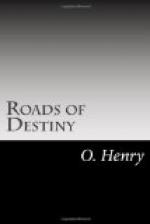Senator Kinney was the picture’s champion and sponsor. It was he who so often stepped forward and asserted, with the voice of a bronco-buster, that it would be a lasting blot, sir, upon the name of this great state if it should decline to recognize in a proper manner the genius that had so brilliantly transferred to imperishable canvas a scene so typical of the great sources of our state’s wealth and prosperity, land—and—er—live-stock.
Senator Kinney represented a section of the state in the extreme West—400 miles from the San Saba country—but the true lover of art is not limited by metes and bounds. Nor was Senator Mullens, representing the San Saba country, lukewarm in his belief that the state should purchase the painting of his constituent. He was advised that the San Saba country was unanimous in its admiration of the great painting by one of its own denizens. Hundreds of connoisseurs had straddled their broncos and ridden miles to view it before its removal to the capital. Senator Mullens desired reelection, and he knew the importance of the San Saba vote. He also knew that with the help of Senator Kinney—who was a power in the legislature—the thing could be put through. Now, Senator Kinney had an irrigation bill that he wanted passed for the benefit of his own section, and he knew Senator Mullens could render him valuable aid and information, the San Saba country already enjoying the benefits of similar legislation. With these interests happily dovetailed, wonder at the sudden interest in art at the state capital must, necessarily, be small. Few artists have uncovered their first picture to the world under happier auspices than did Lonny Briscoe.
Senators Kinney and Mullens came to an understanding in the matter of irrigation and art while partaking of long drinks in the cafe of the Empire Hotel.
“H’m!” said Senator Kinney, “I don’t know. I’m no art critic, but it seems to me the thing won’t work. It looks like the worst kind of a chromo to me. I don’t want to cast any reflections upon the artistic talent of your constituent, Senator, but I, myself, wouldn’t give six bits for the picture—without the frame. How are you going to cram a thing like that down the throat of a legislature that kicks about a little item in the expense bill of six hundred and eighty-one dollars for rubber erasers for only one term? It’s wasting time. I’d like to help you, Mullens, but they’d laugh us out of the Senate chamber if we were to try it.”
“But you don’t get the point,” said Senator Mullens, in his deliberate tones, tapping Kinney’s glass with his long forefinger. “I have my own doubts as to what the picture is intended to represent, a bullfight or a Japanese allegory, but I want this legislature to make an appropriation to purchase. Of course, the subject of the picture should have been in the state historical line, but it’s too late to have the paint scraped off and changed. The state won’t miss the money and the picture can be stowed away in a lumber-room where it won’t annoy any one. Now, here’s the point to work on, leaving art to look after itself—the chap that painted the picture is the grandson of Lucien Briscoe.”




